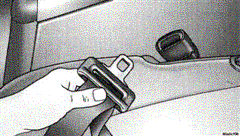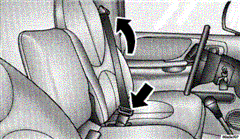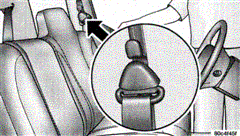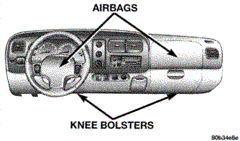THINGS TO KNOW BEFORE STARTING YOUR VEHICLE
Occupant restraints
One of the most important safety features in your vehicle is the restraint system. This system includes the front and rear seat belts and the driver and front passenger airbags. Your seat belts can also be used to hold infant and child restraint systems if you will be carrying children too small for adult-size belts.
Please pay close attention to the information in this section. It tells you how to use your restraint system properly to keep you and your passengers as safe as possible.
| WARNING! |
| In a collision you and your passengers can suffer much greater injuries if you are not properly buckled up. You can strike parts of the inside of the vehicle. Always be sure you and others in your vehicle are buckled up properly. |
Buckle up even though you are an excellent driver. Even on short trips. Someone else on the road may be a poor driver and cause a collision which involves you. And this can happen far from home or on your own street.
Research has shown that seat belts save lives. And they can reduce the seriousness of injuries in a collision. Some of the worst injuries happen when people are thrown from the vehicle. Seat belts provide protection against that, and they reduce the risk of injury caused by striking the inside of the vehicle. Everyone in a motor vehicle needs to be buckled up all the time.
Lap/Shoulder Belts
The outboard front and rear seats of your vehicle have combination lap/shoulder belts. The retractor is designed to lock during very sudden stops or impacts. This feature allows the shoulder part of the belt to move freely with you under normal conditions. But in a collision, the belt will lock and reduce the risk of your striking the inside of the vehicle or being thrown out.
| WARNING! |
Do not allow people to ride in any area of your vehicle that is not equipped with seats and seat belts.
Be sure everyone in your vehicle is in a seat and using a seat belt properly. |
| WARNING! |
| Warning a seat belt incorrectly is dangerous. Seat belts are designed to go around the large bones of your body. These are the strongest parts of your body and can take the forces of a collision the best. Wearing your belt in the wrong place could make your injuries in a collision much worse. You might suffer internal iunjuries, or you could even slide out of part of the belt. Follow these instructions to wear your seat belt safely and to keep your passengers safe, too. |
Lap/Shoulder Belt Operating Instructions
- Enter the vehicle and close the door. Sit back and adjust the seat.
- The latch plate of the belt is above the back of your seat.
Grasp the latch plate and pull out the belt.
Slide the latch plate up the webbing as far as necessary to make the belt go around your lap.

- When the belt is long enough to fit, insert the latch plate into the buckle until you hear a "click".

WARNING! - A belt buckled into the wrong buckle will not protect you properly. The lap portion could ride too high on your body, possibly casuing internal injuries. Always buckle your belt into the buckle nearest you.
- A belt that is too loose will not protect you as well. In a suddden stop you could move too far forward, increasing the possibility of injury. Wear your seat belt snugly.
- A belt that is worn under your arm is very dangerous. Your body could strike the inside surfaces of the vehicle in a collision, increasing head and neck injury. And a belt worn under the arm can cause internal injuries. Ribs aren't as srong as shoulder bones. Wear the belt over your shoulder so that your strongest bones will take the force in a collision.
- Position the lapt belt across your thigh, below your abdomen. If you need the lap portion tighter, pull up a bit on the shoulder part as shown.
A snug belt reduces the risk of sliding under the belt in a collision.

WARNING! A lap belt worn too high can increase the risk of internal injury in a collision. The belt forces won't be at the strong hip and pelvic bones, but across your abdomen. Always wear the lap part as low as possible an keep it snug. - Position the shoulder belt on your chest so that it is comfortable and not resting on your neck.
The retractor will withdraw any slack in the belt.
WARNING! A twisted belt can't do its job as well. In a collision it could even cut into you. Be sure your belt is straight. If you can't straighten a belt in your vehicle take it to your dealer and have it fixed. - To release the belt, push the red button marked "Press" on the buckle.
The belt will automatically retract to its stowed position.
If necessary, slide the latch plate down the webbing to allow the belt to retract fully.
WARNING! A frayed or torn belt could rip apart in a collision and leave you with no protection. Inspect the belt system periodically, checking for cuts, frays, or loose parts. Damaged parts must be replaced immediately. Do not disassemble or modify the system. Seat belt assemblies must be replaced after an accident if they have been damaged (bent retractor, torn webbing, etc.).
Adjustable Upper Shoulder Belt Anchorage
In the front and second row seats, the shoulder belt anchorage can be adjusted upward or downwward to position the belt away from your neck.
Push up or pull down the release button located above the upper belt guide, and then move it up or down to the position that serves you best.
 |
As a guide, if youare shorted than average, you will prefer a lower position, and if you are taller than average, you'll prefer a higher position. When you release the anchorage, try to move it up or down to make sure that it is locked in position.
Center Lap Belts
The center seating positions have a lap belt only.
To fasten the lap belt, slip the latch plate into the buckle.
To lengthen the lap belt, tilt the latch plate and pull. To shorten the belt, pull the loose end of the webbing.
Wear the lap belt snug against the hips. Sit back and erect in the seat, then adjust the belt as tightly as is comfortable.
| WARNING! |
| A lap belt worn too loose or too high is dangerous. A belt worn too loose can allow you to slip down and under the belt in a collision. A belt that is too high will apply crash forces to the abdomen, not to the stronger hip bones. In either case, the risk of internal injuries is greater. Wear a lap belt low and snug. |
| WARNING! |
| Belting two people into one seat belt can lead to greater injury. People belted together can crash into one another in an accident, hurting one another badly. Never use a belt for more than one person, no matter what their size. |
Seat Belts And Pregnant Women
We recommend that pregnant women use seat belts throughout their pregnancies. Keeping the mother safe is the best way to keep the baby safe.
Pregnant women should wear the lap part of the belt across the thighs and as snug against the hips as possible. Keep the belt low so that it does not come across the abdomen. That way the strong bones of the hips will take the force if there is a collision.
Seat Belt Extender
If a seat belt is too short, even when fully extended, your dealer can provide you with a seat belt extender. This extender should be used only if the existing belt long enough. When it is not required, remove the extender and stow it.
| WARNING! |
| Using a seat belt extender when not needed can increase the risk of injhury in a collision. Only use when the lap belt is not long enough when it is worn low and snug, an d in the recommended seating positions. Remove and stow when not needed. |
Child Restraint
Everyone in your vehicle needs to be buckled up all the time --- babies and children, too. Every state in the United States and all Canadian provinces require that small children ride in proper restraint systems. This is the law and you can be prosecuted for ignoring it.
Children 12 years and under should ride properly buckled up in a rear seat, if available. According to crash statistics, children are safer when properly restrained in the rear seats rather than in the front.
| WARNING! |
| In a collision, an unrestrained child, even a tiny baby, can become a missile inside the vehicle. The force required to hold even an infant on your lap can become so great that you could not hold the child, no matter how strong you are. The child riding in your vehicle should be in a proper restraint for the child's size. |
Infants and Small Children
There are different sizes and types of restraints for children from newborn size to the child almost large enough for the adult seat belt.
Use the restraint that is correct for your child:
- The rearward-facing infant restaint is for babies weighing up to about 20 lbs. (9 kg), and one year old or more. The infant restraint must NEVER be used in the front seat of a vehicle with a passenger side airbag unless the airbag is turned off. An airbag deployment could casue sever injury or death to infants in this position. The infant restraint is held in the vehicle by the lap belt or lap/soulder belt.
- The forward-facing child seat is for children from about 20 lbs. to 40 lbs, and at least one year old. The child seat is held in the vehicle by the lap belt or lap/shoulder belt.
- The belt-positioning booster seat is for children weighing more than 40 lbs. The child and booster seat are held in the vehicle by the lap/shoulder belt. (Some booster seats are equipped with a front shield and are held in the vehicle by the lap portion or lap belt.)
Here are some tips for getting the most out of your child restraint:
- Before buying any restraint system, make sure that it has a label certifying that it meets Motor Vehicle Safety Standard 213 --- Child Restraint Systems. DaimlerChrysler Corporation also recommends that you try a child restraint in the vehicle seats where you will use it before you buy it.
- The restraint must be appropriate for your child's weight and height. Check the label on the restraint for this, too.
- Carefully follow the instructions that come with the restraint. If you install the restraint improperly it may not work when you need it. The passenger seat belts are equipped with cinching latch plates designed to keep the lap portion or lap belt tight around the child restraint so that it is not necessary to use the locking clip. Pull up on the sholder portion of the lap/shoulder belt, or on the free end of the lap belt to tighten the belt. The cinching latch plate will keep the belt tight. All seat belts will loosen with time, so check the belt occasionally and pull it tight if necessary.
- In the rear seats, you may have trouble tightening the lap belt or lap/shoulder belt on the child restraint because the buckle or latch plate is too close to the belt path opening on the restraint. Disconnect the latch plate from the buckle and twist the short buckle-end belt several turns to shorten it. Insert the latch plate into the buckle with the release button facing out.
- If the belt still can't be tightened, or if pulling or pushing on the restraint loosens the belt, you may need to do something more Disconnect the latch plate from the buckle, turn the buckle around, and insert the latch plate into the buckle again. If the child restrant still doesn't feel secure, try a different seating position.
- Buckle the child into the restraint exactly as the manufacturer's instructions tell you.
- When your child restraint is not in use, secure it in the vehicle with the seat belt or remove it from the vehicle. Don't leave it loose in the vehicle. In a sudden stop or colision, it could strike occupants and injure them.
| WARNING! |
| Improper installtion can lead to failure of an infant or child restraint. It could come loose in a collision. Follow the manufacture's directions exactly when installing an infant or child restraint. |
Child Restraint Tether Anchor
Some child seat manufacturers recommend the use of a top anchorage (tether) strap in addition to the lap belt. Your vehicle has tether strap anchorages behind the rear seating positions for use with these child seats. Your dealer can provide you with anchorage hardware and installation instructions.
| WARNING! |
| An incorrectly anchored tether strap could lead to seat failure and injury to the child. In a collision, the seat could come loose and allow the child to crash into the inside of the vehicle or other passengers, or even be thrown from the vehicle. Use only the specified anchor positions to secure a child restraint requireing top tether strap(s). |
Children Too Large For Booster Seats
Children who are large enough to wear the shoulder belt comfortably, and whose legs are long enough to bend over the front of the seat when their back is against the seat back should use the lap/shoulder belt in a rear seat.
- Make sure that the child is upright in the seat.
- The lap portion should be low on the hips and as snug as possible.
- Check belt fit periodically. A child's squirming or slouching can move the belt out of position.
If the shoulder belt contacts the face or neck, move the child closer to the center of the vehicle. If this doesn't help, move the child to the center rear seating position and use the lap belt. Never allow a child to put the shoulder belt under an arm.
Driver And Right Front Passenger Supplemental Restraint System (Airbag)
This airbag is certified to the new Federal regulations that allow less forcefull airbags.
This vehicle has airbags for the driver and the right front passenger as a supplement to the seat belt restraint system. The driver's airbag is mounted in the steering wheel. The passenger airbag is mounted in the instrument panel, above the glove compartment. These airbags inflate in higher speed impacts. They work with the instrument panel knee bolsters and the seat belts to provide improved protection for the driver and right front passenger.
 |
| WARNING! |
|
Here are some simple steps you can take to minimize the risk of harm from a deploying airbag.
- Children 12 years and under should ride buckled up in a rear seat, if avialable.
- Infants in rear facing child restraints must NEVER ride in the front seat of a vehicle with a passenger side airbag, unless the airbag is turned off. Airbag deploment can cause severe injury or death to infants in this position.
- If a child from 1 to 12 years old must ride in the front passenger seat because the vehicle is crowded, move the seat as far back as possible, and use the proper child restraint. See the section on Child Restraint.
- All occupants should us their seat belts properly.
- The driver and front passenger seats should be moved back as far as practical to allow the airbag more room to inflate.
Airbag System Components
The airbag system consists of the following:
- Crash Sensor Control Module
- AIRBAG Light
- Airbag/Inflator Units
- Unique Steering Wheen and Column
- Interconnecting Wiring
- Knee Impact Bolsters
How The Airbag System Works
- The Crash Sensor Control Module monitors the reeadiness of the electronic parts of the system whenever the ignition switch is in the START or RUN position. These include all of the items listed above, except the knee bolster and the steering wheel and column. The Control Module also turns on the AIRBAG light in the instrument panel for 6 or 8 seconds when the ignition is first turned on, then turns the light off. If it detects a malfunction in any part of the system, it turns on the light either momentarily or continuously.
- The Airbag/Inflator Units are in the center of the steering wheel and in the instrument panel. When the Control Module detects an impact requiring the airbags, it signals the inflator units. A large quantity of nontoxic nitrogen gas is generated to inflate the airbags. The steering wheel hub and instrument panel trim covers seperate and fold out of the way as the bags inflate to full size. The bags fully inflate in about 50 milliseconds. This is about half the time it takes to blink your eyes. They then quickly deflate by venting the nitrogen gas through holes inthe airbags toward the instrument panel. In this way, the bag does not interfere with your control of the vehicle.
If A Deplyment Occurs
The airbag system is designed to deploy when the impact sensors detect a moderate-to-severe frontal collision, and then immediately deflate.
NOTE: A Frontal collision that is not severe enough to need airbag protection will not activate the system. This does not mean something is wrong with the airbag system.
If you do have a colision which deploys the airbags, any or all of the following may occur:
- The nylon airbag material may sometimes cause abrasions and/or skin reddening to the occupants as the airbag deploys and unfolds itself from the steering wheel.
The abrasions are similar to friction rope burns or those you might get sliding along a carpet or gymnasium floor. They are not caused by contact with chemicals. They are not permanent and normally heal quickly. However, if you haven't healed significantly within a few days, or if you have any blistering, see your doctor immediately. - As the airbags deflate, you may see some smoke-like particles.
The particles are a normal by-product of the process that generates the nontoxic nitrogen gas used for airbag inflation.
These airborne particles may irritate the skin, eyes, nose, or throat.
If you have skin or eye irritation, rinse the area with cool water.
For nose or throat irritation, move to fresh air.
If the irriation continues, see your doctor.
If these particles settle on your clothing, follow the garment manufacturer's instructions for cleaning. - Your vehicle may be safely driveable after the airbags deploy. If so, you can tuck the deployed airbags inside the opening in the steering wheel hub trim cover to make driving somewhat easier. You may tuck the passenger side bag under the trim cover in the right side of the instrument panel.
| WARNING! |
|
Enhanced Accident Response System
If the airbags deploy after an impact and the electrical system remains functional, vehicles equipped with power door locks will unlock automatically. In addition, after the vehicle has stopped moving for approximately 10 seconds, the interior lights will illuminate until the ignition switch is turned off.
Maintaining Your Airbag System
| WARNING! |
|
AIRBAG Light
You will want to have the airbags ready to inflate for your protection in an impact. While the airbag systems are designed to be maintenance free, if any of the following occurs, have an authorized dealer service the system promptly:
- The AIRBAG light does not come on or flickers during the 6 to 8 seconds when the ignition switch is first turned on.
- The light remains on or flickers after the 6 or 8 seconds interval.
- The light flickers or comes on and remains on when driving.
NOTE: If the Speedometer, Tachometer and Engine Gauges are not working, the Airbag Module may also be disabled. The airbag may not be ready to inflate for your protection. Promptly check fuse numbers 18 and 19 in the fuse block. See your dealer if the fuse is good.